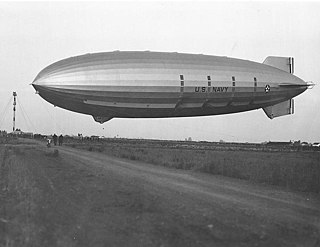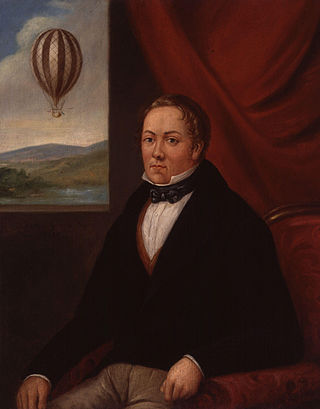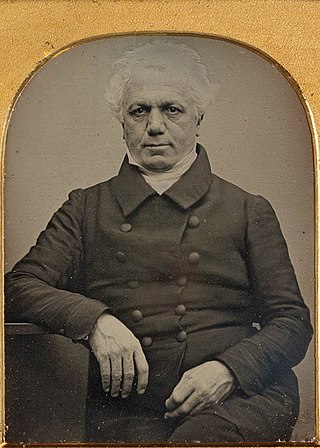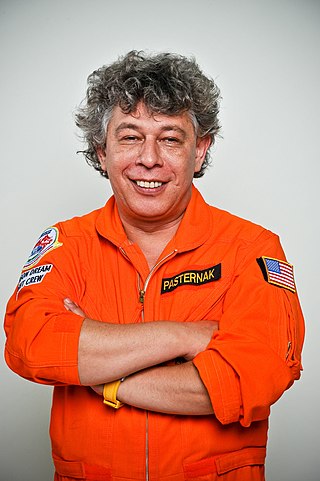
Aeronautics is the science or art involved with the study, design, and manufacturing of air flight-capable machines, and the techniques of operating aircraft and rockets within the atmosphere. The British Royal Aeronautical Society identifies the aspects of "aeronautical Art, Science and Engineering" and "The profession of Aeronautics ."

An airship or dirigible balloon is a type of aerostat or lighter-than-air aircraft that can navigate through the air under its own power. Aerostats gain their lift from a lifting gas that is less dense than the surrounding air.

USS Akron (ZRS-4) was a helium-filled rigid airship of the U.S. Navy, the lead ship of her class, which operated between September 1931 and April 1933. It was the world's first purpose-built flying aircraft carrier, carrying F9C Sparrowhawk fighter planes, which could be launched and recovered while it was in flight. With an overall length of 785 ft (239 m), Akron and her sister ship Macon were among the largest flying objects ever built. Although LZ 129 Hindenburg and LZ 130 Graf Zeppelin II were some 18 ft (5.5 m) longer and slightly more voluminous, the two German airships were filled with hydrogen, and so the two US Navy craft still hold the world record for the largest helium-filled airships.

The history of aviation extends for more than two thousand years, from the earliest forms of aviation such as kites and attempts at tower jumping to supersonic and hypersonic flight by powered, heavier-than-air jets.

John Joseph Montgomery was an American inventor, physicist, engineer, and professor at Santa Clara University in Santa Clara, California, who is best known for his invention of controlled heavier-than-air flying machines.
This is a list of aviation-related events during the 19th century :

Charles Green was the United Kingdom's most famous balloonist of the 19th century. He experimented with coal gas as a cheaper and more readily available alternative to hydrogen for lifting power. His first ascent was in a coal gas balloon on 19 July 1821. He became a professional balloonist and had made 200 ascents by 1835. In 1836, he set a major long distance record in the balloon Royal Vauxhall, flying overnight from Vauxhall Gardens in London to Weilburg, Duchy of Nassau (Germany) a distance of 480 miles (770 km). By the time he retired in 1852, he had flown in a balloon more than 500 times.

Early flying machines include all forms of aircraft studied or constructed before the development of the modern aeroplane by 1910. The story of modern flight begins more than a century before the first successful manned aeroplane, and the earliest aircraft thousands of years before.

Frederick Marriott was an Anglo-American publisher and early promoter of aviation, creator of the Avitor Hermes Jr., the first unmanned aircraft to fly by its own power in the United States.

Patrick Young Alexander was a British aeronautical pioneer fascinated by the possibility of heavier-than-air flight. He was an enthusiastic balloonist and he was also particularly active in meteorology. He performed many meteorological and aviation experiments, designing and building his own equipment. He travelled widely, visiting Australia in his youth and later making many visits to USA – crossing the Atlantic at least 50 times – he travelled widely in Europe and visited Mexico, Russia, Siberia and Africa in pursuit of his interests.

William Samuel Henson was a British-born pre-Wright brothers aviation pioneer, engineer and inventor. He is best known for his work on the aerial steam carriage alongside John Stringfellow.

William Bland was a prominent public figure in the colony of New South Wales. A surgeon by profession, he arrived in Australia as a convict but played an important role in the early years of Australian healthcare, education and science.

Solomon Andrews was a doctor, aviator and dirigible airship inventor. Andrews invented an airship called Aereon which received some notice in the 1860s. He claimed to sail it as one would a sailboat. Mention is made of the movement of pilot and passenger fore and aft in the basket to control attitude. He was a medical doctor and three times Mayor of Perth Amboy, New Jersey. He served as the health officer of Perth Amboy, New Jersey and supervised the construction of the city's first sewer system. He served as the Collector of the Port of New Jersey in Perth Amboy from 1844 to 1845.

Francis Herbert Wenham was a British marine engineer who studied the problem of human flight and wrote a perceptive and influential academic paper, which he presented to the first meeting of the Royal Aeronautical Society in London in 1866. He was the son of a British army surgeon.

Louis Henri Capazza (1862–1928) was a French semi-professional balloonist. He was born in Bastia, Corsica on January 17, 1862. He lived in Belgium from 1892–1898 then emigrated to the United States in about 1920. He died on December 28, 1928, in Paris after contracting pneumonia in Addis Ababa, Ethiopia.

Stanley Edward Spencer (1868–1906) was an early English aeronaut, famous for ballooning and parachuting in several countries, and later for building and flying an airship over London in 1902.
Robert Bland (1730–1816) was an English physician and man-midwife (obstetrician). He was physician to the London Dispensary.
John Benjamin Heath FRS FSA was Governor of the Bank of England from 1845 to 1847.

Igor Pasternak is an American aviation entrepreneur, inventor and engineer specializing in designing and building airships. He is best known as the founder and CEO of Worldwide Aeros Corp, an American manufacturer of airships based in Montebello, California and for his research on variable buoyancy control for airships. Igor Pasternak is an advocate of the cargo airship industry and lighter-than-air flight.
Charles Atherton was a British scientific engineer from Calne, Wiltshire. He was appointed as Chief Engineer and Inspector of Steam Machinery at Her Majesty's Woolwich Dockyard in 1847; and a second time between 1851 and 1862. He served in the same capacity at Her Majesty's Devonport Dockyard between 1848 and 1851.



















